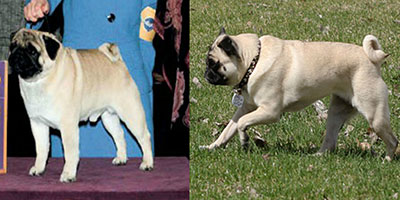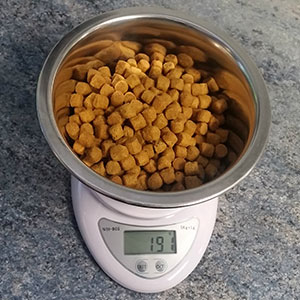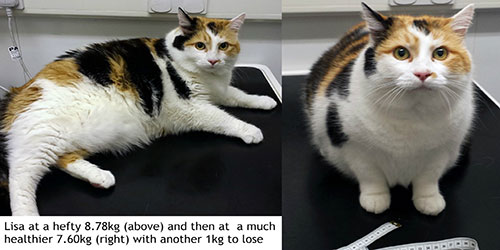Pet obesity is a huge problem in the United Kingdom with an estimated 1 in 3 dogs, cats and rabbits being overweight. Pet obesity is an extremely serious welfare issue in our pets for the following reasons
- Obesity is a preventable disease caused by being fed too many calories
- Obesity can cause a lot of unnecessary suffering in pets
- In some animals obesity can be extremely disabling
- It can affect animals for long periods of their lives
Being overweight can also make it more likely that your pet could suffer from serious health problems and conditions such as:
- Heart disease
- Diabetes
- Breathing difficulties
- High Blood Pressure
- Arthritis, joint problems and injuries
- Skin problems
- Anal Gland problems
- Cystitis
- Incontinence (mainly seen in bitches)
- Ulcers / pressure sores
- Irritability
- Matted fur
- Overweight and obese pets usually have shorter lives than fitter pets
- Fly Strike (Maggot infestation) – this occurs when animals cannot reach their bottoms and clean themselves
- Overweight pets also tend to interact less with their families and are less energetic and playful
Why Are So Many Pets Overweight?
Put simply, because we (their loving owners) feed them too much! Our pets cannot regulate their food intake and exercise like wild animals because they have to rely on us as their owners to provide food and exercise for them. Like humans, pets become overweight when they consume more calories than their body can use and sadly the food and treats we provide often exceed the amount of calories they can burn off through activity, causing them to gain weight. Even pets that get lots of exercise can soon become overweight if they are getting too many calories.
Unfortunately because we see so many overweight pets out and about or on social media, it is normalising obesity and owners are getting the wrong impression of what a healthy dog, cat or rabbit of the ideal bodyweight, should look like. A study published by Veterinary Record 2015 showed that 1 in 4 pedigree dogs that came first to fifth in their breed class at Crufts were overweight, these overweight dogs are winning in classes where they are supposed to be representative of their breed’s optimal condition and fitness!

The “Show” Pug on the left is overweight and the fat rolls around the shoulders should not be there at all. On the right is a Pug at a healthy weight and body condition.
Food Feeding Guidelines
Feeding guidelines for dogs are usually based on active dogs that get 2 or more hours of off-lead exercise daily
The feeding guides on most pet foods are based on the average calorie needs for a particular size of animal, but like humans, no two pets are alike or have exactly the same needs. We need to remember that the feeding advice given on a pet food is just a guide and your pet’s actual needs are often significantly lower than the suggested amount. For example:
- Cat’s have evolved to be skilled hunters, spending hours finding, stalking and catching their prey. It may also take a lot of effort for the cat to kill and then eat and then eat the prey and all of this hard work expends energy and burns calories. Now that our cats are household pets and share their homes with us, they hardly need to expend any energy at all jumping down off the windowsill or sofa and sauntering over to the food bowl
- Dogs that go for long walks every day, are active and constantly on-the-go, will need more calories than dogs that go for short walks during the week and perhaps longer walks at weekends, or are older and more sedentary
- Rabbits have evolved over thousands of years to extract all the nourishment they need from the poor quality vegetation available to them in the wild and require a diet is low in calories and very high in fibre, they also require plenty of exercise and space to run about in. When we keep them as pets they are often given a fairly small space to run about in, in comparison to their wild cousins and we tend to spoil them with treats, sugary veggies, fruits and commercial food, rather than adhering to a more natural diet
Feeding your pet is a balancing act and you may have to increase or decrease the feeding amount every so often to help your pet maintain his or her ideal weight. If you are unsure about how much you should be feeding your pet then please speak to one of our veterinary nurses, who will be happy to help you.
Weigh Daily Food Portions
Did you know that weighing out your pet’s food using a set of digital kitchen scales can make a huge difference to calorie intake? Digital kitchen scales are relatively cheap to purchase (you can even order them from the Castle Vets for £4.99) and are widely available. Weigh out your pet’s dry food portion daily.
If you feed wet food from pouches and tins, it may be easier to work out how many pouches or tins worth of food your pet should have per week and sticking to that amount. This means that they may get more or less food than they should on any given day but they won’t exceed their calorie allowance for the week.
Using a cup, or worse measuring by eye, can actually mean the food amount can differ by up to 50g every day, which could mean that your pet is getting lots of extra calories (sometimes a whole meal or more!).

Always weigh out your pet’s daily food allowance
Tit-Bits and Treats
I am never against giving pets treats and tit-bits, because they are great for rewards, motivation and demonstrating affection, but before you give your pet a treat have a think about the amount of calories it might contain.
As pet owners we may be great at following the feeding guides for our pet’s main meal, but we forget to take into account all of the extra tit-bits and treats that we feed our pets during the day. Did you know that some of the more popular pet chews, treats and dental aids on the market can make up approximately 1/3 or more of your pet’s daily calorie allowance when they are fed the recommended daily portion? Even the very small sized pet biscuits and chews can contain anywhere between 5 and 60 kcals each and, while this may not be a lot of extra calories to a human, this is a huge amount for a small animal (sometimes the equivalent of an extra meal!).
The Golden Rule For Giving Treats Is, If you give any tit-bits or treats you need to reduce your pet’s normal food slightly to compensate.
Manipulation
Our pets can become extremely good at manipulating us and many quickly learn that if they perform certain behaviours i.e. barking, meowing, head nudges and “the big- eyed look” they will get a treat or some more food in their bowl. Dogs can quickly learn which family member they are more likely to get food from and we all know how hard it is to ignore the cat that sits by the food bowl and meows pitifully until someone gives in? (Did you know that cats rarely meow at other cats? this behaviour is generally reserved for getting something from their humans!)
Some pets certainly have their owners sussed out, but it is up to you to teach yourself to ignore your pet when he or she does this. In most cases the pet just wants attention from you, so try involving them in a play or petting session rather than giving them food.
Scavenging
Some pets are real scavengers and will happily steal food off plates, kitchen counters or bins as well as scavenging anything edible on their daily walks. Some cats like to visit several different houses and ask for or steal food and let’s not forget the pets that steal food from others in the household. There are many ways to prevent this behaviour, so please contact us for advice.
Illnesses and Medications
Some illnesses can cause weight gain particularly if they slow down the metabolism and/or cause fluid to build up in various parts of the body, but this should not be confused with fat gain. Your vet will be able to assess your pet and advise you about whether you should help them to lose some weight or not.
We Do It Because It Makes Our Pets Happy and Love Us
While this may be true on some levels, you can make your pet very happy in other ways; for example through play, training and daily interactions like stroking.

Lisa was much happier and more mobile after she had lost some weight.
How To Tell If Your Pet Is Overweight
It is often difficult for owners to see that their pets are overweight because weight gain in pets can be so gradual, that we just don’t notice until someone points it out to us.
The next time you stroke your pet run your hands over their back, chest, and tummy areas. Gently feel all over your pet’s body, applying only very light pressure
Feel along the ribs (chest area)
Can you feel an outline of the ribs properly without applying any pressure at all? If not, your pet is likely to be overweight
Feel along the waist and tummy
Can you feel or see an abdominal tuck from the side of the animal and above? If not, your pet is likely to be overweight
Feel down along the spine
Can you feel the spine ? If you cannot feel the spine properly your pet may be overweight
Look at your pet when he/she is sitting down
Can you see any places where the skin rolls over onto other parts such as the base of the tail, the shoulder and neck area and tops of the legs? If you can, then your pet is likely to be overweight
Have a look at these Body Condition Score Charts, dogs and cats should have a score of 4-5, rabbits should have a score of 3. If your pet scores above (or below) speak to one of our veterinary nurses about your pet’s weight.
Dog body condition score (Royal Canin)
Pug BCS Chart – University Of Cambridge
Cat body condition score (Royal Canin)
Rabbit body condition score (PFMA)
What Castle Vets Can Do To Help
Helping your pet lose weight will require a commitment to the weight loss and overall fitness of your pet from the whole family, but is well worth the effort and is easier than you think.
Our free Healthy Weight Clinic is managed by qualified and registered veterinary nurse Clare Espley, who has a special interest in animal nutrition. After assessing your pet, Clare will make a weight loss plan that is based on your pet’s lifestyle and individual requirements and advise you on the best way for you to help your pet lose his or her excess weight and keep it off.
Many pets are able to lose weight on their current food however, it is important that your pet’s food is not reduced too much or they may miss out on necessary nutrients. Each pet attending the Healthy Weight Clinics will have a weight loss plan designed to meet their individual requirements and for those pets that cannot lose weight on their own food we may recommend they are put on a special veterinary calorie controlled diet.
Regular monitoring and weight checks are essential to ensure that your pet is losing weight at a safe rate and so that any adjustments to your pet’s diet can be made as necessary. It is very important that dieting pets lose weight at a controlled and steady rate to prevent illness, cats especially can be at risk if they lose weight too quickly. During the Healthy Weight Clinic appointments your pet will be weighed and measured and any adjustments to your pet’s diet and exercise can be discussed. Most pets really enjoy coming in for these appointments and even the nervous ones soon relax once they learn that they are not going to be poked and prodded by a vet!
To make an appointment for the Healthy Weight Clinic you can contact Castle Vets on 0118 957 4488
What You Can Do To Help Your Pet
Weight loss is hard for anyone whether four legged or two legged, but losing weight can vastly improve your pet’s quality of life and can help your pet live much longer. It is really important that anyone who interacts with your pet understands that he or she is on a diet and must not be given extras; explain to everyone involved the benefits of keeping your pet fit and healthy and why they must cut out all of those extra food treats.
Tips and tricks
- Speak to your Veterinary Nurse. Your veterinary practice will usually offer free clinics to monitor and give advice regarding dieting pets. They will be able to help you to help your pet lose weight and get healthy. Don’t be embarrassed to talk to them about your pet’s weight, they won’t judge you
- Weigh out your pets daily food amount on a set of kitchen scales rather than guessing. Measuring feeding amounts by eye or by using a feeding cup or scoop is not very accurate at all and even a few extra biscuits every day soon adds up
- Make sure you exercise your dog properly (even if it is raining) and remember that if your dog doesn’t get his or her walk, for whatever reason, then you should reduce the amount of food that you give for that day
- Cut out all of those unnecessary tit-bits or cut back slightly on your pet’s main food
- Cats meow and dogs will bark or whine for lots of reasons – don’t be tempted to think that they are hungry every time they make a noise, because they may just be saying hello or asking for a fuss and some attention. Dogs, cats and small pets that enjoy company, will get pleasure from being groomed with a gentle brush or comb, especially if it’s on your lap in the evening
- Cats will often refuse to go out if the weather is not good so try to encourage more activity through play and spending time with your cat to get him or her chasing toys and moving around
- Involve your pet in some sort of training to stimulate his or her mind, finishing up with plenty of praise. Dogs, cats, rabbits and small animals can all be trained and taught new things; even short training sessions will burn calories
- If your dog enjoys a treat now and then, try them with a piece of raw carrot or another vegetable. If you feed a dry diet, a few biscuits from their daily allowance can be put aside to feed as rewards or tit-bits without adding extra daily calories
- If you are giving your pets treats on a regular basis make sure you reduce the amount of food in their daily meals accordingly
- Try spreading your pet’s food over several small meals throughout the day rather than 2 big meals morning and evening. If you are out during the day, investing in a timed feeder can help with this.
- Rabbits and other small animals can benefit from toys such as balls and tunnels, which are especially good if they are edible and made from natural fibre and grasses. There is a fantastic array of foods on the market that are wholesome and beneficial but also help you to feel you are giving your pet something special
- You can use scatter feeding to slow down your pets eating, make food last longer and make eating fun. This can be achieved by literally scattering dry food about, either on the lawn (dogs only) or in the home, or by using items such as buster cubes and balls that dispense the food as they are moved about. You can also use puzzle feeders and make your own toys to hide food in
- Play with your pet, to encourage activity. Playing fetch with a ball or toy, or having a gentle game of tug will help dog’s burn off some calories. Encourage cats with dangling toys, small balls and feathery toys and if your cat likes catnip, this can be great for encouraging movement and activity. Remember to keep your cat’s play sessions to short bursts of 3-5 minutes each time as this is what they prefer. Rabbits can also be encouraged to play by providing a variety of toys and some will even play fetch with you
Try and find out who the ‘sneaky feeders’ are amongst your family and friends; many people give pets food without even realising they are doing it!